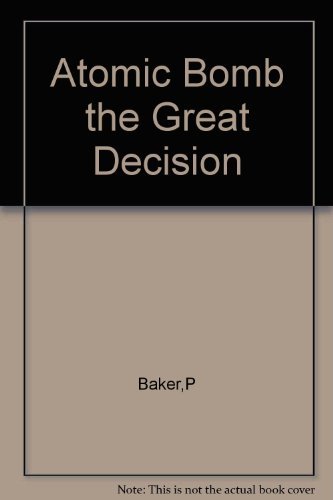The Atomic Bomb : The Great Decision - Softcover

"synopsis" may belong to another edition of this title.
- PublisherHolt, Rinehart & Winston
- Publication date1968
- ISBN 10 0030676355
- ISBN 13 9780030676352
- BindingPaperback
- Edition number1
- Number of pages122
Shipping:
US$ 5.25
Within U.S.A.
Top Search Results from the AbeBooks Marketplace
The Atomic Bomb : The Great Decision
Book Description Trade Paperback. Condition: Very Good. First Edition. 122 Pages. This is a book in The American Problem Studies series published in 1968. Tight bright book with no marks and interior text pages are near flawless. The cover illustration is the Industrial Exposition Hall, Commercial Display Building, Hiroshima Japan, 1945, shortly after the atomic blast. Among the significant historical events of the twentieth century few surpass in dramatic impact and long-range importance the dropping of the two atomic bombs on Japan in the summer of 1945. The world at large was suddenly notified that a new era of human history had opened; with the testing of the first device at Alamogordo, New Mexico, in July 1945 and the destruction of Hiroshima and Nagasaki in August, the atomic age had begun. Man now had at his control a force capable both of bringing destruction and. of doing work on an unprecedented scale. But with this new power, he soon became, to a degree, a creature of his own invention: the very existence of usable nuclear energy has been a fundamental determinant of the course of domestic and international relations since 1945. The direct impetus for the program of atomic weapons development in the United States came in 1939. Late in the summer of that year, with the world on the verge of war, two Hungarian refugee scientists, Leo Szilard and Eugene Wigner, became convinced of the need for systematic American investigation of the possible utilization of the power within the nucleus of the atom. Fearful of German research activity in this area, they persuaded Albert Einstein to sign a letter to President Roosevelt revealing that powerful new bombs might be developed and urging that American research be accelerated and given public support. In August 1942, the Manhattan Engineer District, established under the War Department, set about to develop an atomic bomb. Directed by Brigadier General Leslie R. Groves, the Manhattan Project grew to a vast size; eventually some two billion dollars were spent and some 150,000 persons employed. Huge plants were built at Oak Ridge, Tennessee, and at Hanford, Washington, while laboratory research was carried on principally at the University of Chicago and at Los Alamos, New Mexico. Even before July 16, 1945, when the new bomb was first tested secretly, controversy over use of the revolutionary device was building up within the scientific community. This book is the history of the arguments regarding the morality and the fallout after the bombing. Contents: Problems of Strategy To End The War, Diplomatic Fencing and the Cold War, The Moral Dimensions, The Bomb and the World Today (1968), and A Summary View. Seller Inventory # 19711

